Слайд 2New Zealand is an island country in the south-western Pacific Ocean comprising

two main islands, the North Island and the South Island.
The indigenous Māori named New Zealand Aotearoa, The Land of the Long White Cloud.
North Island is known among the Māori as Te Ika a Māui (the fish of Māui) and the South Island as Te Wai Pounamu (the waters of greenstone) or Te Waka o Aoraki (the canoe of Aoraki).
Слайд 3The Māori
The Māori are the indigeneous people of Aoteraoa

Слайд 15The Kakapo, also called owl parrot, is a species of nocturnal parrot
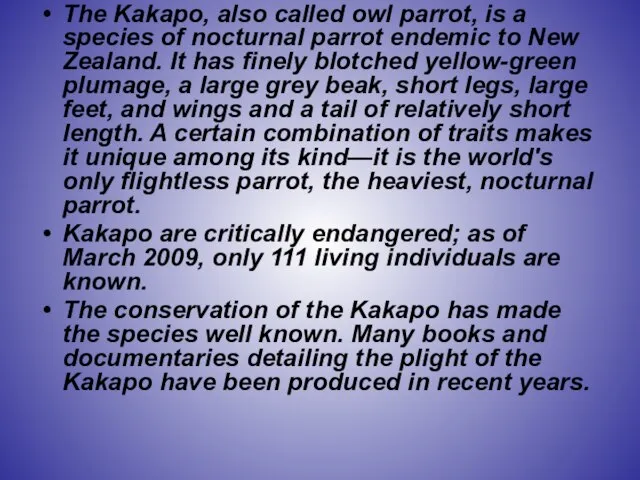
endemic to New Zealand. It has finely blotched yellow-green plumage, a large grey beak, short legs, large feet, and wings and a tail of relatively short length. A certain combination of traits makes it unique among its kind—it is the world's only flightless parrot, the heaviest, nocturnal parrot.
Kakapo are critically endangered; as of March 2009, only 111 living individuals are known.
The conservation of the Kakapo has made the species well known. Many books and documentaries detailing the plight of the Kakapo have been produced in recent years.
Слайд 19A kiwi is any of the species of flightless birds endemic to
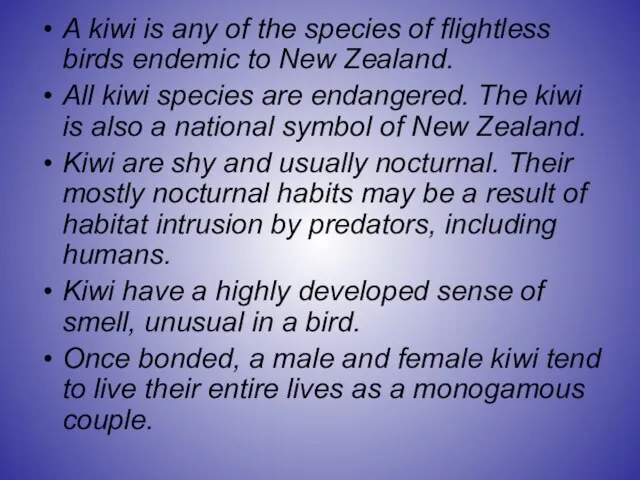
New Zealand.
All kiwi species are endangered. The kiwi is also a national symbol of New Zealand.
Kiwi are shy and usually nocturnal. Their mostly nocturnal habits may be a result of habitat intrusion by predators, including humans.
Kiwi have a highly developed sense of smell, unusual in a bird.
Once bonded, a male and female kiwi tend to live their entire lives as a monogamous couple.
Слайд 22The Kea is a species of parrot found in forested and alpine
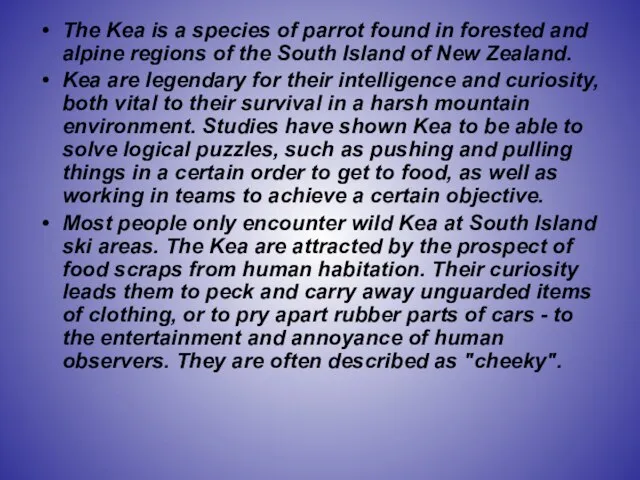
regions of the South Island of New Zealand.
Kea are legendary for their intelligence and curiosity, both vital to their survival in a harsh mountain environment. Studies have shown Kea to be able to solve logical puzzles, such as pushing and pulling things in a certain order to get to food, as well as working in teams to achieve a certain objective.
Most people only encounter wild Kea at South Island ski areas. The Kea are attracted by the prospect of food scraps from human habitation. Their curiosity leads them to peck and carry away unguarded items of clothing, or to pry apart rubber parts of cars - to the entertainment and annoyance of human observers. They are often described as "cheeky".
Слайд 25Takahe
The Takahē is a flightless bird indigenous to New Zealand.
The adult Takahē
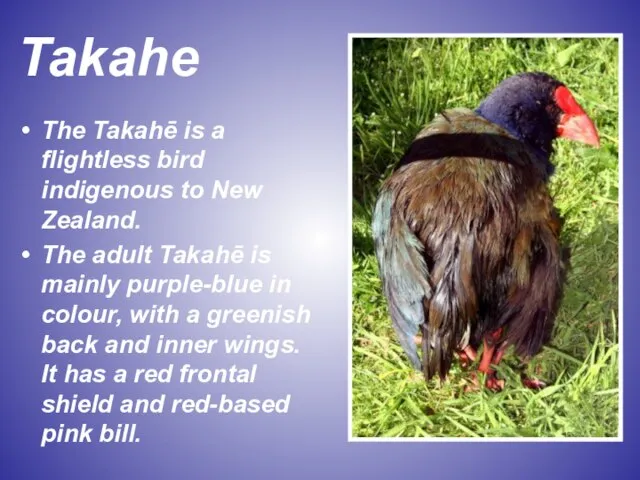
is mainly purple-blue in colour, with a greenish back and inner wings. It has a red frontal shield and red-based pink bill.
Слайд 27Many weta are large by insect standards and some species are among
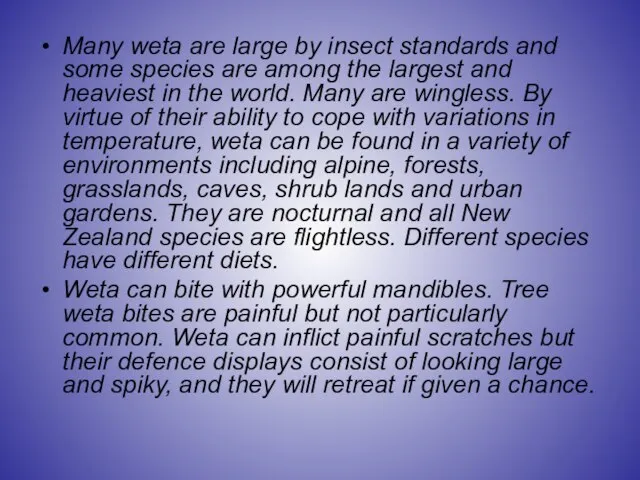
the largest and heaviest in the world. Many are wingless. By virtue of their ability to cope with variations in temperature, weta can be found in a variety of environments including alpine, forests, grasslands, caves, shrub lands and urban gardens. They are nocturnal and all New Zealand species are flightless. Different species have different diets.
Weta can bite with powerful mandibles. Tree weta bites are painful but not particularly common. Weta can inflict painful scratches but their defence displays consist of looking large and spiky, and they will retreat if given a chance.











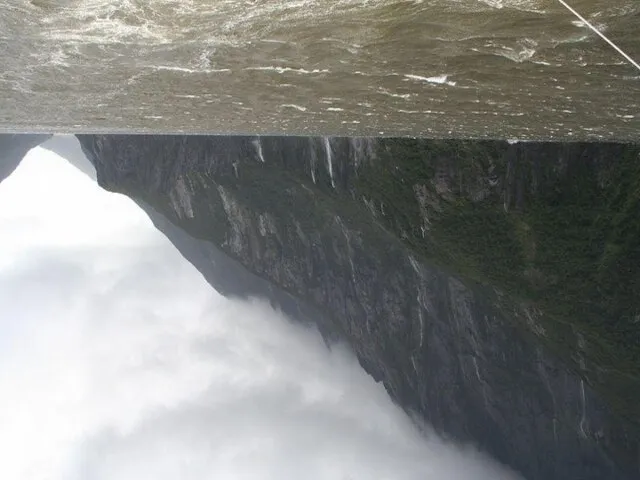
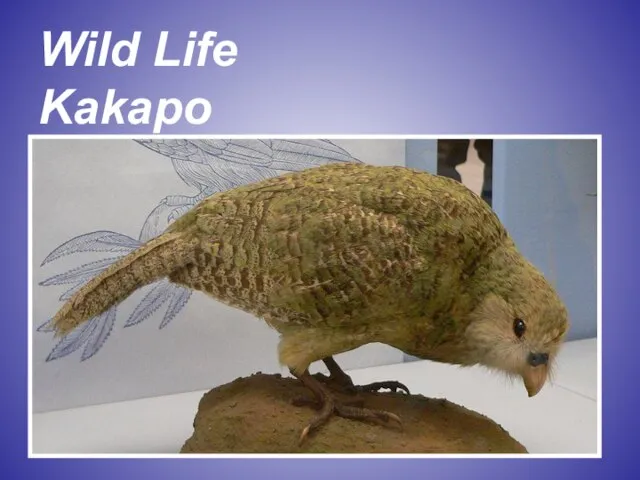

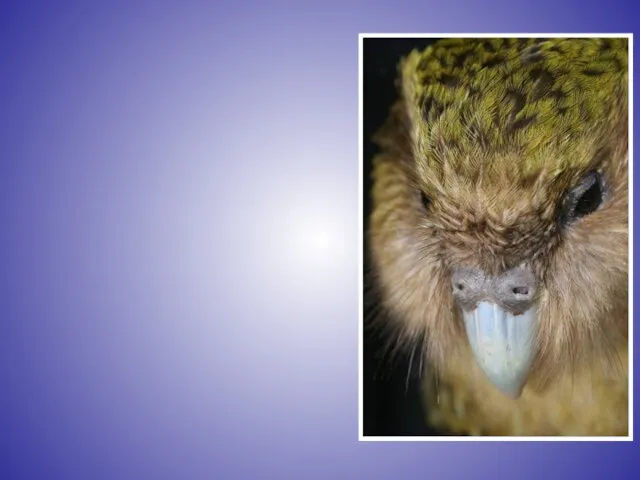
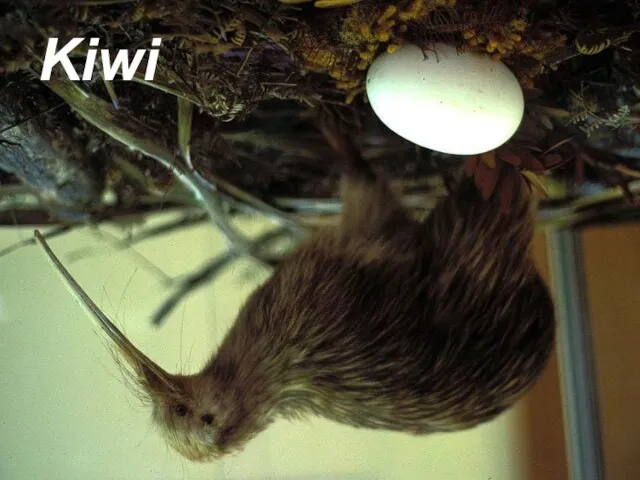
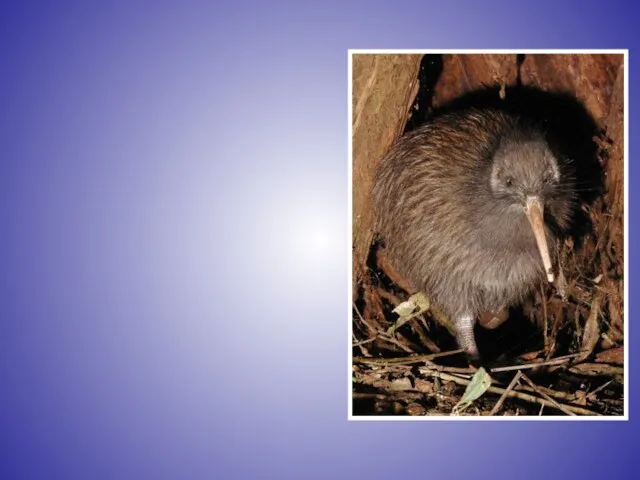

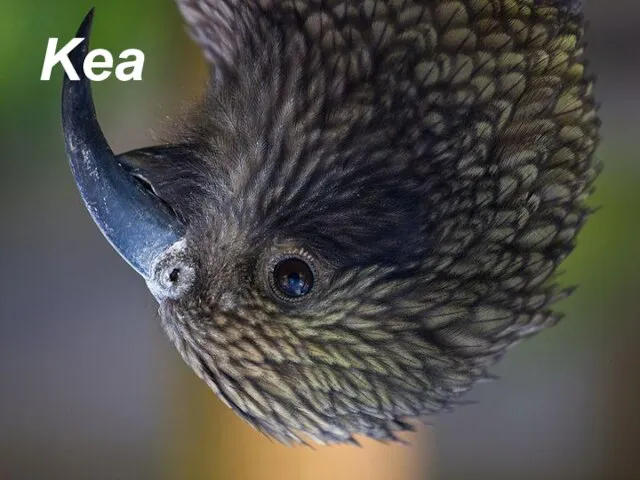
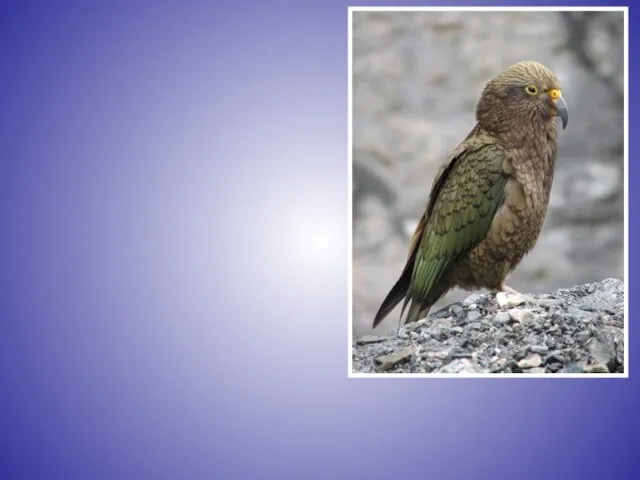

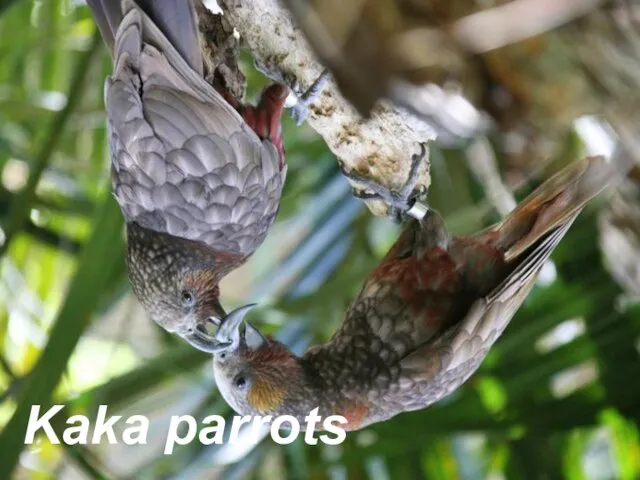
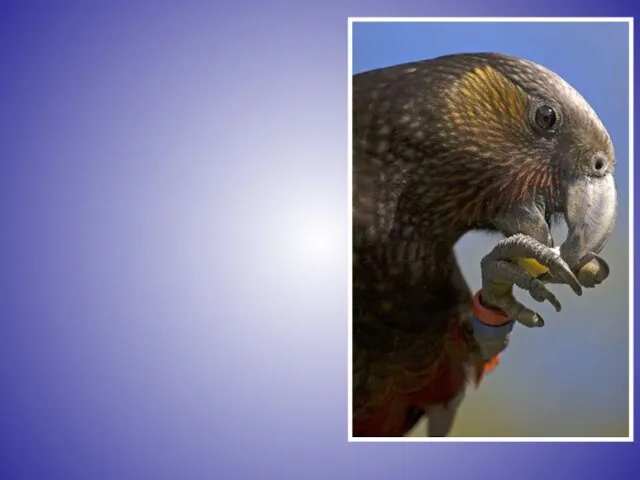

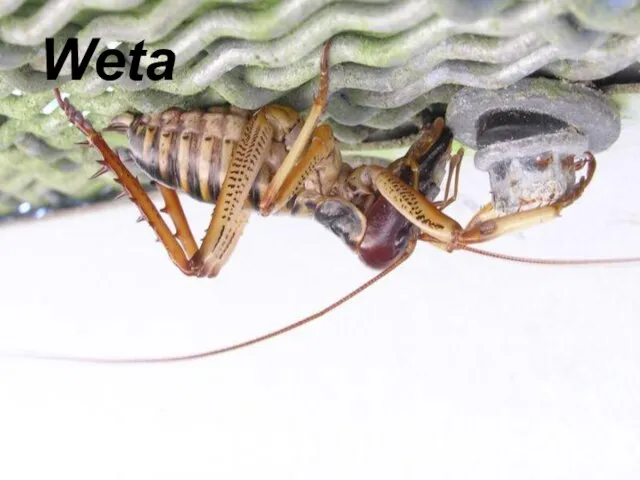

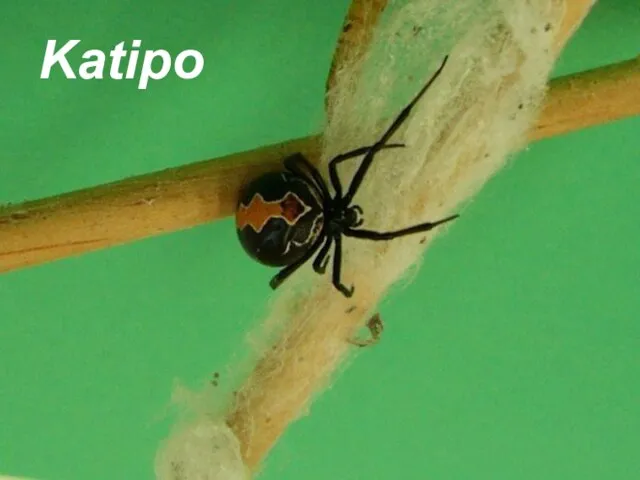
 Адаптация
Адаптация НПК туризм Ямала
НПК туризм Ямала Международные отношения в новое время
Международные отношения в новое время Основные ошибки при подаче документов на лицензирование
Основные ошибки при подаче документов на лицензирование Расчет схемы состава пассажирского поезда
Расчет схемы состава пассажирского поезда Публичный доклад о состоянии и перспективахразвития системы образованияГосударственного бюджетного дошкольного образователь
Публичный доклад о состоянии и перспективахразвития системы образованияГосударственного бюджетного дошкольного образователь Хәтерләүдән курыкма син! Үткәннәрне онытма син. Бел син ерак бабайларның Ничек итеп көн иткәнен
Хәтерләүдән курыкма син! Үткәннәрне онытма син. Бел син ерак бабайларның Ничек итеп көн иткәнен Олег Андреев Oracle СНГ Руководитель региональных проектов, государственный сектор.
Олег Андреев Oracle СНГ Руководитель региональных проектов, государственный сектор. Методы управления ЖК-Дисплеем
Методы управления ЖК-Дисплеем Плавание судов
Плавание судов PPT Единицы измерения и сбор данных
PPT Единицы измерения и сбор данных задача
задача Рекомендации родителям учащихся подросткового возраста
Рекомендации родителям учащихся подросткового возраста Делу время, потехе час
Делу время, потехе час Водоподготовка и водный режим в теплогенерирующих установках
Водоподготовка и водный режим в теплогенерирующих установках Сколько будет единыжды один?
Сколько будет единыжды один? ИНСТИТУТ СОВРЕМЕННОГО РАЗВИТИЯ Первые 50 дней
ИНСТИТУТ СОВРЕМЕННОГО РАЗВИТИЯ Первые 50 дней Животный мир Австралии
Животный мир Австралии Дипломный проект
Дипломный проект Презентация на тему Здравствуй, школа!
Презентация на тему Здравствуй, школа! Понятие многогранников и их виды…
Понятие многогранников и их виды… Презентация на тему Люди и судьбы. А.И. Солженицын – истинный интеллигент, гражданин нашей страны.
Презентация на тему Люди и судьбы. А.И. Солженицын – истинный интеллигент, гражданин нашей страны.  The world of rebuses and riddles
The world of rebuses and riddles Форма фотоотчет 2022
Форма фотоотчет 2022 Концепция круглогодичного профессионального Индор гольф центра
Концепция круглогодичного профессионального Индор гольф центра Перевод земель иных категорий в земли населенных пунктови изменение вида разрешенного использованияземельных участков.Актуал
Перевод земель иных категорий в земли населенных пунктови изменение вида разрешенного использованияземельных участков.Актуал Тема урока:
Тема урока: Правоохранительные органы Российской Федерации
Правоохранительные органы Российской Федерации